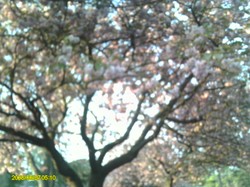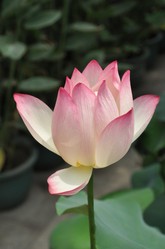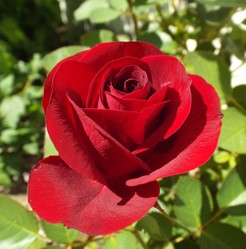Burial customs have varied throughout history. They have ranged from simple burials right up to elaborate inhumations such as the ancient Egyptian pyramids. In recent years as humans have become more ecologically conscious, certain people have questioned whether the amount of land used in graveyards can be justified, and they also question the use of memorial stones and expensive coffins. There are also questions about the use of cremation, as it uses much expensive fuel and disposal of the ashes can be the source of problems in some cases. The use of natural burial grounds is growing.

Green Funerals
by frankbeswick
Some environmentally concerned people are opting now for burial in a woodland without coffins made from non-biodegradable materials or expensive wood.
Funeral traditions
The tradiional ways of dealing with bodies in the West are burial and cremation, and both have their advantages and disadvantages. Burial allows a body to return to the Earth, but it is expensive and demanding of land.Ground that can be used for housing or food is used for graveyards and full of expensive stone memorials. But while cremation uses far less land than burial does, it is expensive in fuel as burning a body completely takes high temperatures for a reasonable length of time, and so it is a source of carbon dioxide pollution in the air. Many people nowadays opt for a green funeral, in which the body is buried in a natural setting, such as a woodland. This avoids CO2 pollution and the waste of fuel, and it still returns nutrients to the Earth, which can be used by plants growing on the site.
This is a return to a mediaeval tradition practised by monks. If you visit the site of a mediaveal monastery you will be struck by the absence of the monks' gravestones. This is because individual monks are not given a memorial because they were heaven-focused. Instead they were wrapped in a winding sheet and buried in the monastery orchard, where their bodies would nourish the fruit trees. Their ceremonials of death used few resources like coffins and flowers. They are a model for the modern, ecologically conscious age.
Green burials
 | Final Rights: Reclaiming the American Way of Death Abuse of consumers by the funeral industry has only worsened in the decades since Jessica Mitford's landmark expose The American Way of death.Families are exploited financially ... |
 | Dying Green |
Low Resource Funerals
A typical green or natural funeral does not over-consume resources. It is low impact. The user of a green burial dislikes the waste of resources that happens when a coffin is buried or burned. Good, solid hard wood, often with metal handles and occasionally with plastic fittings, made from oil that is growing increasingly scarce are consigned into the earth or the fire, Instead the supporter of the green funeral will use a much simpler coffin, if at all. It is possible to be buried in a wicker coffin, which consists of basically a basket. Some coffins are made of light wood, even plywood.There have been coffins made of scrap wood Like the monks we can be buried in a winding sheet. Importantly, our burial vessel will not use overmany resources, and metal and plastic will not be consigned uselessly to the earth
Some funeral directors are reluctant to be involved in the green burial industry because they are making so much money from selling expensive coffins, but others will do so. There are some people who now make their own coffins and a growing number of funeral directors will be prepared to accept a coffin that the deceased or their family has made.
It is important to realize that a low resource funeral is not a cheapskate funeral. There are too many people who think that the deceased must have a good send off in a coffin of the best wood suitably lined. Put simply, the deceased is not going to be lying in the coffin enjoying the high quality of its interment residence. In cremation all this high quality material goes into the incinerator. A green funeral is the expression of the values of those who love the Earth; and while being earth- loving, it is deeply spiritual.It expresses a spirituality that sees the earth as sacred. The monks, as we saw, had the greenest of burials, and they were heaven-focused, spiritual people. Their monastic gardens and orchard were for them sacred places that were intended to recreate Eden, so they were where earth and heaven met
The spiritual side of green funerals is not linked to any specific religion. The monks, as we saw, were Christian, but Buddhist monks are no different in this respect. Pagans are great supporters of low impact burials, as one of their strong points is their love for the Earth.
Bereavement
 | Healing After Loss: Daily Meditations For Working Through Grief For those who have suffered the loss of a loved one, here are strength and thoughtful words to inspire and comfort. |
The Green Burial Ground
Some farmers and landowners have been making ground available for green interments. There is a wide variety of sites, but often they are a woodland. Sometimes this is an existing wood, but at others it might be planted for the purpose. This will have to be a well-maintained woodland as a wild one will be inaccessible to the mourners because of the scrub that fills it. The key to a good green burial ground is that it is spacious enough to allow mourners to reach the grave and that the spaces between the trees are kept trimmed for ease of access. It is thus nearer to a garden than a wild place. This is realistic, it is a cultivated place not a wilderness. Some people like a site with a view, but it is not as if the dead are going to be enjoying it, so many people do not think that this matters. It is more for the mourners than the deceased.
Of vital importance is the ban on memorial stones. These can be expensive drains on families' resources and they wear away in the end. The average grave is visited for fifteen years and then forgotten. So advocates of green burial insist that gravestones are a waste. Instead a tree can be planted over the grave. This might be fruit tree that can produce fruit for visitors to enjoy. However, a word of advice. You might have to wait the suitable time for planting, as trees need to be planted in the dormant period. This is sometime between October and March. In specially planted woods the woodland grows as more and more people are buried.
Some people have simple wooden memorials. A Christian might have a small wooden cross. These are unobtrusive and eventually decay back into the soil. Decay is to be welcomed as it is essential to the natural cycle of life.
I must admit that I am deeply impressed with the ancient monastic way of burial. The service is done and then the body in its winding sheet is simply confined into an orchard/woodland and allowed to decay in the confidence that it is the spirit that lives on in God. The monastic past is a guide to a greener future.
Graves
 | How to Read a Graveyard: Journeys in the Company of the Dead Death is the one certainty in life, yet, with the decline of religion in the West, we have become collectively reluctant to talk about it. Our contemporary rituals seek to sanit... |
You might also like
British Country ShowsBritain has a rich assortment of country shows, be they flower shows, agricul...
The Health Benefits of GardeningGardeners do not live for ever, Adam and Eve didn't, but they tend to be hea...
The Philosophical GardenerGardening is an activity that draws upon a wide range of skills and knowledge.



 The North Wales Pilgrim Path29 days ago
The North Wales Pilgrim Path29 days ago
 Rewilding the Isle of the Thundergodon 02/17/2024
Rewilding the Isle of the Thundergodon 02/17/2024
 Adrienne von Speyr a life on the edge of heavenon 01/24/2024
Adrienne von Speyr a life on the edge of heavenon 01/24/2024
 The Granite Kingdom: a Cornish Journeyon 12/29/2023
The Granite Kingdom: a Cornish Journeyon 12/29/2023




Comments
A small tree.
Your comments Oct. 23, 2014, consider among tree species in a green-funeral woodland "small fruit" trees.
Is that a fruit tree of small stature -- ;-D -- or a fruit tree with small fruit ;-D?
Your comments March 1, 2014, and Oct. 23, 2014, indicate a woodland burial, near a fruit tree, without a headstone.
Will your green-burial ground need to be Church-consecrated?
If so, how much in advance would that consecration take place?
We don't have enough information to resolve this question, but it is likely that the Christian practice of sharing out relics of saints and martyrs would have been significant in making the dispersal of Thomas' ashes.
Two events that happened in ancient India inspired my question about dispersed, non-dispersed ashes.
Mauryan Emperor Ashoka initiated a policy of dispersing asthi avashesh (from Sanskrit अस्थि, “bone” and अवशेष, “remainder”), in contrast to previous commitments to keeping ashes intact. That policy involved even Gautama Buddha relics, especially his teeth, being dispersed throughout India and even into Myanmar.
St. Thomas perished in what now is Chennai, capital city of Tamil Nadu, southernmost India. Various sources suggest that some relics remained there and other relics elsewhere.
Would it be true that St. Thomas' relics were dispersed?
If so, would that have happened because of taking place in India influenced by the Ashokan dispersals or because of a Church toleration -- for dispersal and non-dispersal -- that subsequently changed to non-dispersal?
The Catholic Church would not scatter ashes, as it prefers burial to cremation, hence the question of where a saint's ashes would go does not arise.
There's a trend on my, western side of the (Atlantic) pond to scatter a loved one's ashes where he/she died and wherever he/she loved being or wanted to be in life.
The other day an acquaintance indicated that a nephew had died young and that the parents had divided his ashes among necklace lockets for those he loved and who loved him. Another acquaintance mentioned that ashes should be kept together.
If the above be true, it seems contradictory that saintly relics get dispersed to different saintly places.
Would dispersals be something for saints and non-dispersals for those not recognized as saints with saint days?
Your feelings harmonise with mine, Katie. I love the earth and am happy that when I go this body will nourish it. My ideal is not a headstone, but a small fruit tree, then ordinary people can feed off its fruits. In a land where the poor are turning to food banks to eat, free food will benefit the poor.
I am a HUGE advocate for green funerals. I keep telling "myself" take care of the details so that my wishes will be carried out. I do not want to be buried in all the commercial waste. I love the sheet wrap, I would be the most comfortable wrapped in a simple sheet and buried simply in the warmth of the earth. I love our magnificent earth and enjoyed your article immensely. I am sharing this all around. Thanks for taking the time to write such a thoughtful and helpful article.
Burial without a coffin or headstone? I'm fine with that. But my husband wouldn't go for it. He would think it disrespectful.